A shared zone is defined in the Land Transport (Road User) Rule 2004 as ‘a length of roadway intended to be used by pedestrians and vehicles’ (including cycles). A shared zone should only be considered in streets where vehicle speeds and vehicle volumes are low or discouraged.
Shared zones aim to eliminate the segregation of road users, and as such, no formal areas for pedestrians and vehicles are normally provided. There is no physical separation by a kerb or level differences to define areas for particular users. In shared zones, the needs and comfort of pedestrians are paramount. People driving and cycling in shared zones are expected to act like guests, travelling in a way that is consistent with a walking pace, and are legally required to give way to pedestrians.
Shared zones encourage low vehicle speeds, make easier for people to move around, and create a relaxed environment where people feel welcome walking, lingering or stop and having a chat. Shared zones, therefore, also promote social interaction and increase social cohesion. When in commercial areas, like towns or city centres, shared zones can also be vibrant spaces with outdoor dining, public seating, landscaping, etc. When in residential areas, shared zones can act as an extension of the front yard and create places for outdoor playing areas, meet the neighbours, etc.

Oxford Terrace, Christchurch - shared zone in a commercial area. (Photo: Jeanette Ward)
Shared zones however need careful planning and design, and attention to detail to avoid visual cluttering, poor parking behaviour and to not create issues for some disabled people (such as neurodivergent people and blind or partially blind people) or less confident pedestrians (for example, elderly and children) who can feel intimidated by sharing the same space with vehicles.
Shared zones may be implemented to the full length of a street or only to a part of a street. Their implementation can be a tool to transition from the current state to the aimed (future) state of a street.
The image below of the One Network Framework matrix for urban environments shows the street categories where shared zones may be considered. More information on these streets categories can be found here:
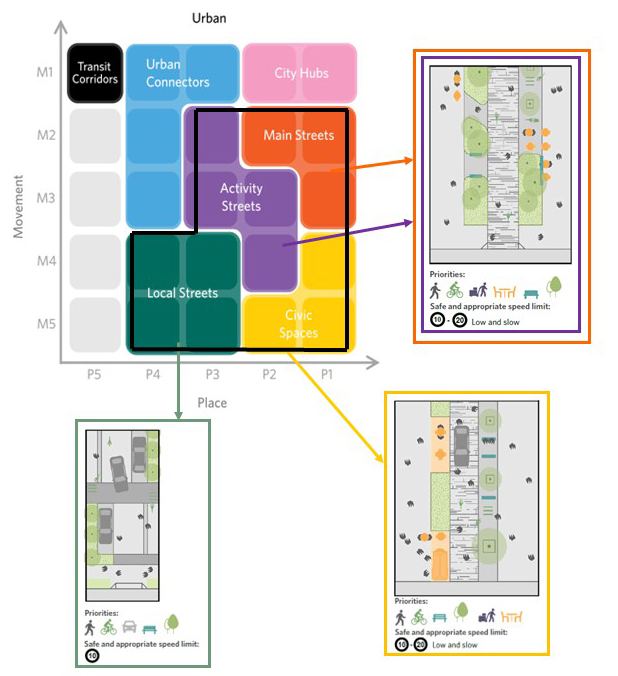
One Network Framework matrix for urban environments.
A shared zone is defined in the Land Transport (Road User) Rule 2004 and is created by a Road Controlling Authority (RCA) via a “traffic resolution” being approved by elected council or community board or, in the case NZTA Waka Kotahi by published gazette notice. In both cases, this process creates a “bylaw”. This “bylaw” is the legal instrument and enforcement relies on the existence of the “bylaw”.
On the ground the boundaries of the shared zone are indicated by installing the A40-7 Shared Zone sign (shown below), as specified in the Traffic Control Devices (TCD) Rule.
The specifications of the A40-7 Shared Zone sign are outlined in the TCD Manual Sign Specifications (NZTA: Sign Specifications). When installed, this sign informs users that the roadway beyond the sign is within a shared zone for the purposes of clause 10.2 of the Land (Road User) Rule 2004. Clause 10.2 states that:
(1) A driver of a vehicle entering or proceeding along or through a shared zone must give way to a pedestrian who is in the shared zone.
(2) A pedestrian in a shared zone must not unduly impede the passage of any vehicle in the shared zone.
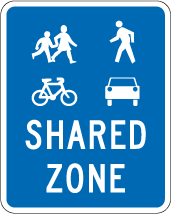
A40-7 Shared Zone sign (Source: NZTA Sign Specification)
A photograph of the application of this sign is shown below.
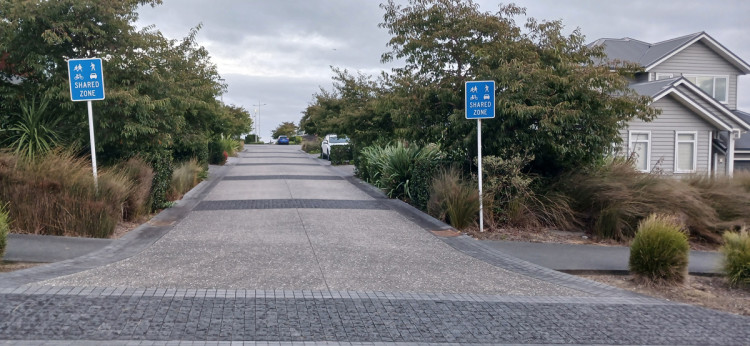
Entry to a shared zone in a residential area, Copper Lane, Auckland. (Photo: Geoff Haines)
RCAs may wish to support a shared zone by introducing a lower speed limit (for example, 10km/h). Placement of associated speed limit signs needs to be clear. Shared zones are based on the concept of integration, rather than separation, of road users. If a lower speed limit is introduced, then vehicles are required to travel at nearer walking speed with the result that the environment is more friendly to pedestrians.
Other signs may be used to communicate, for example, where general vehicles may load/unload for servicing or that cycles are vehicles that can use the space at any time.
Land Transport (Road User) Rule 2004(external link)
TCD Manual Sign Specifications: Shared Zone
The design of shared zones should take into consideration and be sympathetic to the area’s specific environmental and cultural characteristics, incorporate CPTED and universal design principles, and the aims and objectives of the street.
Shared zones should only be considered in streets where vehicle speed and volumes are low or discouraged. According to a study undertaken in London by Transport for London[1] concluded that there is a threshold of around 100 vehicles per hour for the street to function as a shared space. Above this threshold, people see the general path as a ‘roadway’ they need to cross rather than a space to occupy and use.
Vehicle restrictions may also be considered, such as regulating delivery access to, for example, only certain times of the day or restricting entirely private vehicle access while maintaining access to taxis and car ride share vehicles. Movable planters or other type of movable street furniture can be used to enforce vehicle restrictions.
Note that when parking regulations are to be enforced then signage is required (for more details refer to TCD Manual). However, as few as possible signs should be provided. Alternative to signage is a change in pavement and surface markings. These however must be combined with regulatory signage at the entry of the shared zone to be enforced. Road controlling authorities can also create bylaws restricting/banning parking in shared zones.
TCD Manual Part 13 Parking control [PDF, 690 KB]
When the shared zone is one-way for motor vehicles, cycling in both directions should be allowed. Allowance for contra-flow cycling needs to be added to the local bylaw. For guidance on contra-flow cycling, see the Cycling Network Guidance – Provision for contra-flow cycling.
CNG: Provision for contra-flow cycling
When designing a shared zone is recommended to consult the Royal New Zealand Foundation for the Blind, neurodivergent advocacy groups and other special interest groups in the community.
For shared zones in commercial and mixed-use areas to be successful, they should have appropriate levels of activities both day and night time and attract high levels of pedestrians. Street activities can be generated by people visiting shops, cafés, outside play areas, public spaces and other destinations. Therefore, shared zones in commercial and mixed-use areas should be implemented on streets on pedestrian desire lines, where adjacent land uses support the creation of social/people places and place making features such as benches and artwork. This encourages people to stay and linger rather than passing through.
Shared zones in commercial and mixed-use areas have been previously referred to shared spaces streets. The legal term however is shared zone, and this is the recommended and encouraged term to use when referring to this type of street.
Shared zones in commercial and mixed-use areas bring several benefits to the individual as well as to the community:
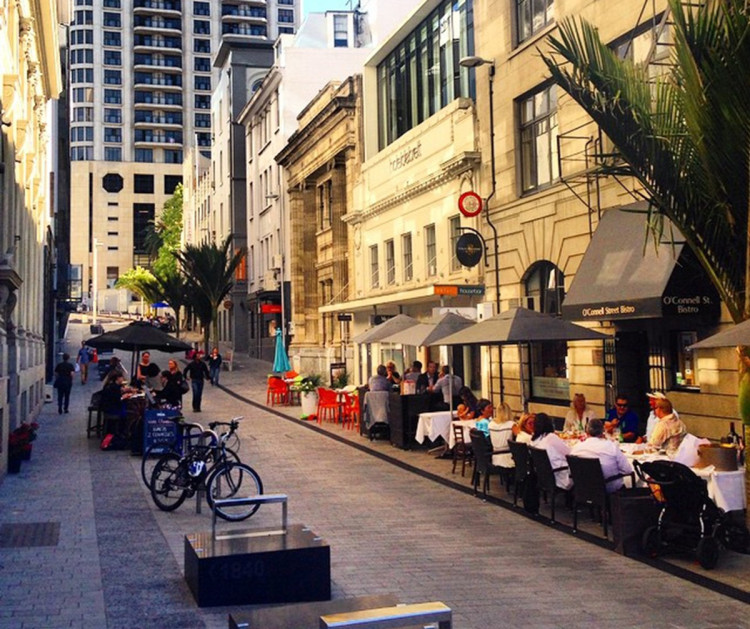
O’Connell Street, Auckland – shared zone in a commercial area. (Source: Auckland Council)
Shared zones in commercial and mixed-use areas are characterised by absence of kerbs and footpaths, active building frontages and limited parking. This reinforces the message that in these streets people driving, cycling and wheeling are guests, travelling in a way that is consistent with a walking pace, and are legally required to give way to pedestrians. They are also characterised by an abundance and variety of street furniture (for example, benches, cycle parking) and/or landscaping treatments (such as. trees, planters) supporting an attractive and welcoming walking environment.
It is recommended that shared zones in commercial and mixed-use areas are one-way flow for vehicles, with a bylaw allowing people cycling in both directions. This reduces the complexity of the environment for all users, particularly pedestrians.
Although pedestrians may walk and cross anywhere in a shared zone, a clear (of obstructions and vehicles) continuous path along the building lines ensures pedestrian access to the buildings is maintained and makes the street inclusive for all users.
Where there are building overhangs or verandas ensure that the vehicle movement zone is guided away from these features. This can be done through strategic placement of street furniture.
A residential shared zone is a quiet, local street in a residential area. Shared zones in residential areas can act as an extension of the front yard where neighbours meet and socialise, children can play safely outside, people of all ages can cycle and walk safely or people can just sit, relax, and do nothing. Vehicles travel at a low speed and are treated as guests.
Shared zones in residential areas have been previously referred to home zones. The legal term however is shared zone and this is the recommended and encouraged term to use when referring to this type of streets.
Shared zones in residential areas bring several benefits to the individual as well as to the community:
These zones should be tailor-made and designed to fit within the characteristics of the street and space. Key to the design and successful implementation and use of a shared zone in a residential street is the involvement of the local community and the understanding of ‘place’. As such the design team should be multidisciplinary and include among others an urban designer and/or a landscape architect, a transport planner/engineer. Also important in developing a holistic and successful design is to have clear objectives, together with regular design reviews that bring together the design team and the local community.
Shared zone streets in residential areas can be two-way or one-way flow for vehicles as these are less complex spaces than commercial areas.
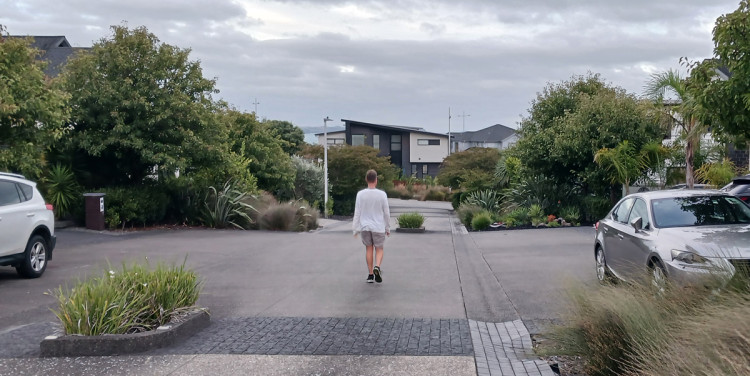
A shared zone in a residential area, Auckland. (Photo: Geoff Haines)
Apart from the general principles for shared zones irrespectively if they are in a residential or commercial area as discussed in the PNG: Key design principles of shared zones, below are some further principles[2] that should be considered when planning and designing shared zones in residential areas.